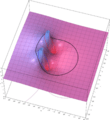Cauchy's integral formula facts for kids
In mathematics, Cauchy's integral formula is a very important idea in complex analysis. This is a special part of math that deals with complex numbers. The formula is named after a famous mathematician called Augustin-Louis Cauchy.
It tells us that if you have a special kind of math function (called a holomorphic function) that works inside a circle, you can figure out everything about that function just by knowing its values on the edge of that circle. The formula also gives us ways to calculate all the derivatives (which show how a function changes) of these special functions using integrals.
Cauchy's formula shows that in complex analysis, finding derivatives is a lot like doing integrals. This is different from "real analysis," which deals with regular numbers. In complex analysis, these operations work nicely even when things get very close to a limit.
Contents
What is Cauchy's Integral Formula?
Cauchy's integral formula helps us understand holomorphic functions. These are functions that are "smooth" and "well-behaved" in the world of complex numbers. Imagine a function that doesn't have any sharp corners or breaks when you look at it in a special way.
How it Works with Circles
The formula says that if you have a holomorphic function inside a circle, its value at any point inside that circle can be found by looking at its values only on the circle's edge. It's like knowing what's happening on the outside of a balloon tells you everything about the air inside.
Derivatives and Integrals
One cool thing about this formula is that it connects two big ideas in math: differentiation and integration.
- Differentiation is about finding the rate of change of a function.
- Integration is about finding the total amount or area under a curve.
In complex analysis, Cauchy's formula shows that these two operations are closely related. This makes complex analysis very powerful for solving tough problems.
Why is it Important?
Cauchy's integral formula is a cornerstone of complex analysis. It has many uses in different areas of science and engineering.
Understanding Complex Functions
It helps mathematicians and scientists understand how complex functions behave. It shows that these functions are very "rigid" or "structured." If you know a little bit about them, you can know a lot.
Solving Real-World Problems
This formula is used in many fields. For example, it helps in physics to solve problems related to fluid dynamics or electromagnetism. It's also used in engineering for things like signal processing.
Images for kids
See also



